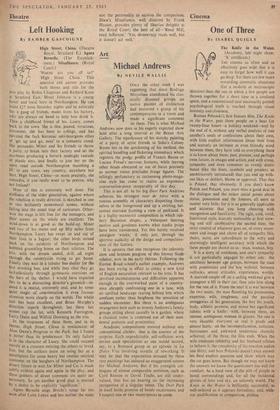Art
Michael Andrews
By _NE VILE WALLIS
ONLY the other week I was regretting that since Rodrigo Moynihan abandoned his clas- sically disposed groups no native painter of distinction had mustered a group of his contemporaries in a room and made a significant comment on them. This is what Michael Andrews now does in his eagerly expected show held after a long interval at the Beaux Arts Gallery. The significance of his sketchy painting of a party of artist friends in Soho's Colony Room lies in the quickening of his method, the spirited handling and flickering immediacy which registers the podgy profile of Francis Bacon or Lucian Freud's nervous features, while leaving other heads obscured or out of focus precisely as normal vision precludes fringe figures. The tellingly perfunctory or cartooning photo-maga- zine style has come to realise an expressive conversation-piece inseparably of th,s- day.
This is not all In his big Deer Park Andrews achieves his strangest tour de force with a riotous assembly of characters disporting them- selves in the foreground and up a swirling bal- conied staircase framing a view of parkland. It is a highly mannerist composition in which rub- bery Baconian shapes, a Velasquez hunting motive and goodness knows what studio props have been transmuted. Yet this barely resolved amalgam 'works,' if only just, through the sportive audacity of the design and compulsive- ness of the fantasy.
It is upstairs that one recognises the infinitely slow and hesitant progress of this former Slade scholar, now in his early thirties. Following the Euston Road school's earlier example, Andrews has been trying in effect to create a new kind of English naturalism relevant to his time. It has involved inconsistencies and difficulties apparent enough in the overworked paint of a country- man abruptly confronting one in a lane, with an uptilted landscape rearing behind him which confuses rather than heightens the sensation of sudden encounter. But there is an ambiguous strangeness here such as invests Andrews's family groups sitting about casually in a garden, where a classical order is contrived out of their acci- dental postures and proximities.
Academic compositions revived without any conventional clichés: that is the essence of the surprise. Each unpredictable, self-sufficient work invites such speculation as one would accord, say, to a Bonnard group or an episode in La Dolce Vita involving months of reworking. It may be that the expectation aroused by these rare paintings has induced an exaggerated esteem for Michael Andrews. But if his youngish col- leagues of almost comparable ambition, such as Cyril Reason or David Tindle, are still under- valued, that has no bearing on the increasing recognition of a singular talent. The Deer Park in itself holds promise of heady excitements and I suspect one or two masterpieces to come.


































 Previous page
Previous page